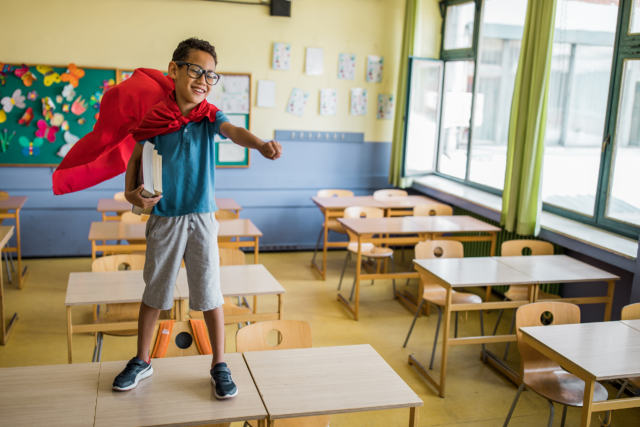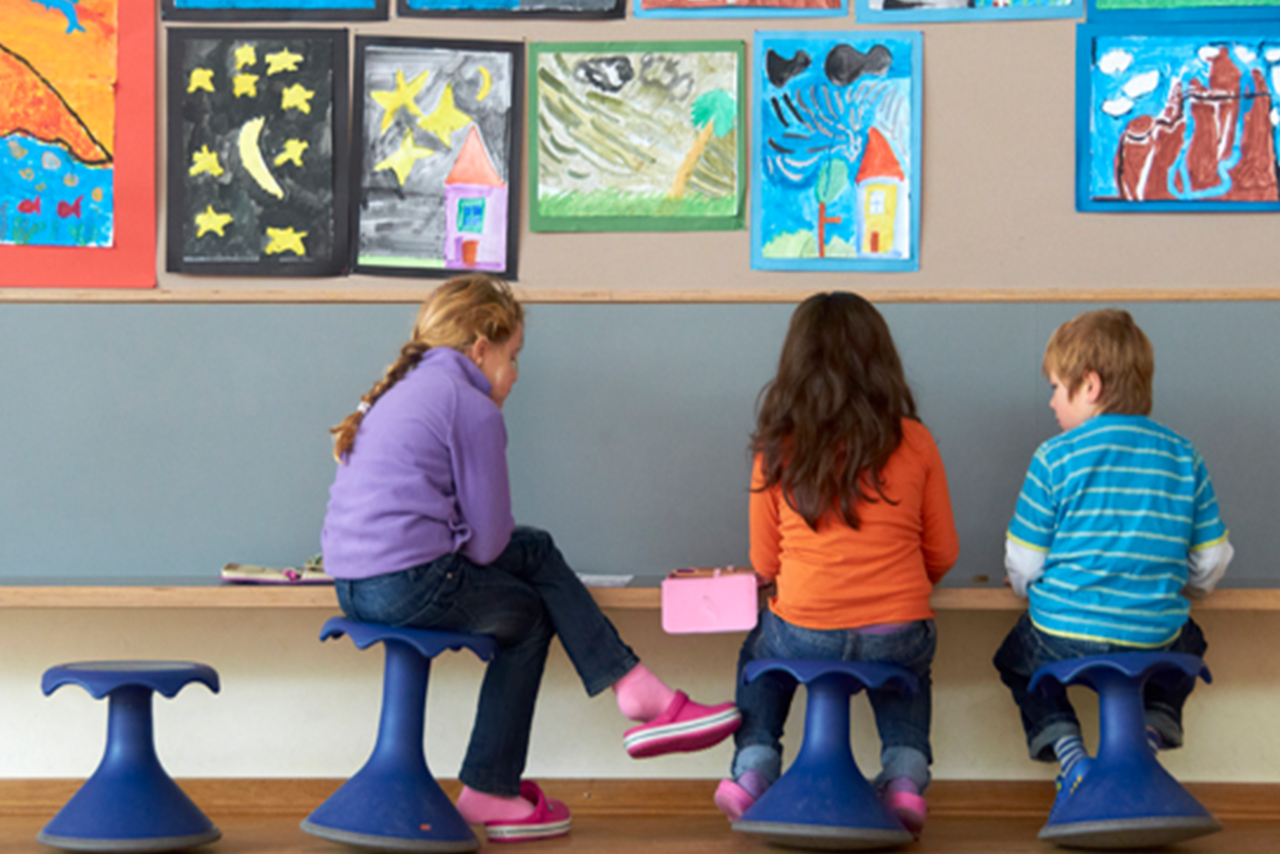The “Classroom of the Future” in Hindsight: Post Occupancy Analysis

Months after implementation, we looked at 19 “Classrooms of the Future” with students and educators. Here are our lessons learned.
Fans of the 1989 film Dead Poets Society will remember the pivotal scene of teacher John Keating’s line “I stand upon my desk to remind myself that we must constantly look at things in a different way.” Mr. Keating’s perspective of the classroom serves as both a literal and metaphorical approach for designers of education spaces today. Design professionals play a critical role to shape the classroom landscape to not only support learning from students, but to enable the instructors to creatively adapt their teaching techniques to promote active learning. Active learning is an instructional approach that deepens the engagement of students in the material they are learning through problem-solving activities, writing assignments, group discussion, reflection activities, and other tasks which promote critical thinking about the subject matter.
An active learning classroom is a physical environment that facilitates this method. But, how can this fundamental shift in education philosophy be accommodated in traditional brick and mortar school buildings? Furniture is the primary medium to offer a retrofit approach. The traditional classroom furniture of the last 50+ years cannot keep up with forward-thinking educators and the synchronization of technology, flexibility, and multi-functionality to support interactive learning. Any form of sitting still, whether physical, mental, or metaphorically, is counterproductive to the model of the “Classroom of the Future.”
Furniture is perhaps one of the most tangible elements of the built environment. When thinking of tasks you accomplish in any given day how many of them are affected by the use of furniture? Every morning we rise from our beds, put our shoes on at a chair, sit at our desks in the office, take a book off the shelf, share a meal with family at the dinner table, and if we’re lucky, relax on the sofa at the end of the evening. With so much interaction with furnishings they become highly subjective and personal to the occupant of the building and essential to the successful completion of the tasks that require their use. Furniture that occupants use consistently throughout the day, particularly, provokes a visceral and emotional response.
In the spring of 2018, LaBella and Hilton Central School District embarked on a space analysis and furniture refresh project that has overhauled the traditional classroom setting. Teachers submitted applications to participate in the project and ultimately 19 teachers and their classrooms were selected across three different schools to pilot the concept of the “Classroom of the Future.” The grade levels of the classrooms ranged from kindergarten to 8th grade. The furniture package was issued for bid in late fall of 2018 and installation took place during February break of 2019. Following a four-month period of use, LaBella conducted interviews and surveys with teachers and students to analyze the impact of the furniture selection, layout, and design process.
The key to successful problem-solving is to first identify and define what that problem is. The design team approached the project by meeting one-on-one with teachers and observing the classroom in action. From there, the design team documented trends and needs from space to space, classroom population and typical group sizes within, instructional methods, and physical barriers to active learning. Design starts with preliminary furniture selections and initial layouts showing these pieces. These are reviewed individually with instructional staff to further plan, make selections, and discuss the flexibility and reconfiguration of different zones of the classroom. The classroom planning is heavily dependent on involvement from instructional staff.
The design team encourages discussion about classroom “zones” to help instructors think about space and function. Often, when designing the room itself, these zones overlap and share characteristics. Flexibility and multifunctionality is paramount to classroom design when working in small classroom spaces with 28+ students. Furniture that is easy to relocate allows for seamless adaptability to the demands of group work, independent study, and broad instruction.

Rather than apply a one-size-fits-all design solution to each space, the “Classroom of the Future” concept is based around the idea of variety, access to power and technology anywhere students decide to work, and display of information to inspire creative thought and problem- solving. Students and educators are better able to manipulate their environments by using an assortment of types of furniture and other elements. A middle school teacher at Hilton commented, “No matter where I am around the room I am able to sit with a group of students, use a white board, and conduct ‘mini’ lessons within each group!” During observations of the classroom it was noted that some students used any surface of the space available to complete their work, whether independent or in a group. Many students preferred even to sit on the floor. To embrace choice in work location and facilitate comfort for students to maintain focus – specifically on the floor- the designers specified elements such as area rugs, floor cushions, and coffee tables. The area rugs offered the unexpected bonus of creating a more intimate, living room feel for parent- teacher discussions and independent reading.
In an era where attention spans have significantly declined due to the use of mobile communications technology, collaboration and social interaction has been proven to be essential to the engagement of the Digital Natives in the classroom. Technology cannot offer the sense of community, of shared experience and purpose that the educational setting can provide. There is no substitute for the sense of place that a school creates for its students. It is as much a part of the educational experience as teachers, classmates, and study. A collaborative learning environment promotes a student’s social interaction, builds self-esteem, and enhances satisfaction with the learning experience.
At Hilton, collaboration and group work was found to be heavily influenced by table shapes and sizes. Certain table configurations proved to be more effective for certain age ranges. For instance, for kindergarten through second grade clover-shaped and round tables over 60 inches in diameter were found to be too large for students’ arm span if items were placed in the center of the table. For testing and other independent work, table shapes that clearly identified the personal space of the individual students (and provided demarcation for even spacing) were beneficial.
Our test classrooms indicated two notable departures from current design trends in adult workspaces.
First, in adult workplaces, recent data suggests that the use of sit-to-stand desks and accessories is significantly diminished after one month of ownership, making the cost of those systems hard to justify for most corporate environments. Contrary to this trend, the use of multi-height sit-to-stand tables and workstations was much more consistent in the K-12 environment over the months following installation. This coud be attributed to growing/changing bodies, youthful exuberance, or a reaction to the general confinement to the same classroom that elementary-age school children experience.
Likewise, less paperwork, more digital processes, and smaller computers have resulted in office workstations trending smaller. Contrary to this trend, in the Hilton classrooms, LaBella and district personnel discovered there is a need for an increase in individual workspace size per person in the classroom setting. The integration of technology has actually added workspace tools, while traditional supplies are still very much in use. Depending on the task, students in a given period were found in to use Chromebooks, notebooks, text books, and supply bins simultaneously- requiring larger tables and desks for both individual and group work.
In general, the use of tables versus individual desks proved to open the door to one-on-one discussions and instruction with students by teachers. Multi-height and counter or bar height tables further enhanced this benefit. One fifth grade teacher commented, “I am more often at the student’s level now, [allowing] for more conversations.”
With the movement away from the traditional student desk with personal storage, the designers made sure to incorporate furniture to encourage communal storage practices. Mobile storage units with a mix of bins, open shelving, and cabinets also allowed more flexibility for the occupants to move furniture to divide the classroom, creating more intimate work zones or larger group work spaces. Many of the mobile storage units were specified with a marker board surface on the back, adding functionality to the storage. Storage units with clear bins were especially important for lower grade levels. Young students need to be able to see the materials within the bin so that they have the autonomy to find and get what they need to learn. Double-sided mobile marker boards provided ample flexibility to instructors that teach multiple classes. The teachers found they didn’t need to erase in between classes because they had the additional surfaces on the opposite side.
Some furniture models and configurations were found to effectively detract from the curriculum and were viewed as distractions by both students and educators at Hilton. Immediately after occupancy, several teachers recognized the need to implement changes to classroom policies and protocol. In many cases, classroom management became challenging for teachers because students were returning to their now revamped classrooms within the same school year. Changes required management of new behaviors that arose, new cleaning procedures, new rules regarding movement of furniture by students within the classroom, and monitoring equality in choice of seating configurations. Once new routines emerged within the redesigned classrooms the students adapted to the new expectations of management and their focus increased. A fifth grade teacher even remarked that focus was sustained for longer durations of time than with the previous furniture. With new practices in place, instructors found that their own approach to teaching changed. One fourth grade teacher confirmed, “My instruction has become less teacher-driven and more teacher-facilitated.”
For elementary grade levels, teachers appreciated the absence of casters on seating, but preferred it on tables and storage units. It was determined during the design process and early meetings with teachers that casters on seating for grades 6 and under would lead to a classroom management problem as young students would wind up viewing the mobile seating as toys. The use of active seating- that is, with a wobble, sway, and bounce function- was found to be much more appropriate to lower age levels than casters. Teachers at Hilton unanimously commented that student engagement, focus, and listening was highly enhanced by active seating, specifically in students with ADD, ADHD, and those on the Autism spectrum. Spaces and furniture designed to promote movement have also been shown to combat the sedentary tendency associated with mobile communications technology.
Just as it was important to introduce active seating, the design team made use of traditional 4-leg classroom chairs in all classrooms as well, which was appreciated by students for use during certain tasks. These 4-leg chairs were given equal design consideration, and included thoughtful features like built-in handles for better mobility, flexible backs for increased movement, and a modern approach to color. Often many of the active seating options available to K-12 environments are backless. It was noticed that students sometimes sought out the comfort of a traditional chair with a back as a reprieve to sitting in a backless active seat for a duration of time.
Considering the right ratio of stools, soft seating, and traditional chairs is critical.
In classrooms polled by the designers, the students unanimously commented that the comfort level of the seating in general was increased. They appreciated having the privilege of choosing where they could complete their work in the space that would be conducive to their learning style and personality. Surprisingly, the classrooms that had areas of lounge seating were most often the student- preferred work zones. As such, teachers wished that more pull-up tables and writing surfaces near the lounge pieces were incorporated into the program. Overall, the use of bold and colorful finishes was preferred by students in lieu of neutral colored materials. Both findings are consistent with the broad movement toward the creation of sensory-rich environments in the practice of interior design.
“Classrooms of the Future” are a unique project type that are heavily dependent upon involvement of individual end users- the teachers and students for each space. 100% of the teachers we interviewed thought that the Classroom of the Future program should continue to other classrooms at Hilton. A successful “Classroom of the Future” is enhanced by the design team’s attentiveness to the occupant needs and goals for how the built world affects the human experience and aspiration. The design team at LaBella has certainly learned a lot from the pilot programs we’ve been a part of. We’re eager to share that knowledge as we continue to work in support of education.

About the Author
Anne Weis, CIDInterior Designer
Anne has 17 years of experience in the design of healthcare, assisted living, K-12 education, and municipal environments. Anne is a detail- oriented person that strives to craft interiors that are ecologically and socially responsible. She has a knack for creating unique, high-impact design solutions that emphasize the goals and character of her clients’ organizations.